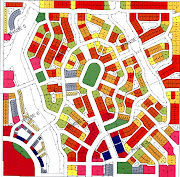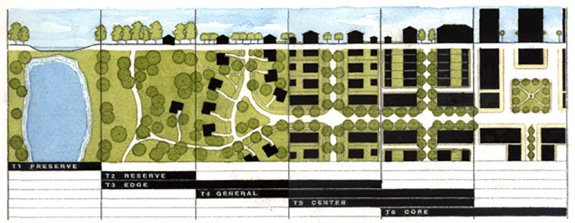Tuesday, October 31, 2006
300 Million People on Our Way to 400 Million . . .
Click here to refresh: http://www.newherbanism.blogspot.com/
The United States just crossed the 300 million population mark and this suggests that we consider what will happen as we head to the 400 million mark which we will hit some time around 2040.
Right now each person is taking almost 20 percent more developed space than 20 years ago. We can not continue our car-dependent land-use pattern on the way to 400 million people without acute environmental damage and heavy quality-of-life costs, reports USA Today writer Haya El Nasser, citing experts whose calls for alternatives have strongly resonated among the public especially this electoral season.
''We're going in the wrong direction right now. The rate of land consumption is twice the rate of population growth,'' points out Smart Growth America Executive director Don Chen. ''There's been a real change in the American consumer looking at how they live,'' observes Cambridge-based Lincoln Institute of Land Policy Public Affairs Manager Anthony Flint, author of This Land: The Battle Over Sprawl and the Future of America. ''We've been spreading ourselves out generously and thinly across the land because we could. Energy was cheap. It made sense to satisfy our longing for elbow room, wide open spaces, a sense of security and . . . affordability.''
Virginia Tech's Metropolitan Institute Co-director Arthur C. Nelson expects the next 100 million residents to add 73 million jobs, about 70 million housing units and 100 billion square feet of non-residential space, mostly in the major metropolitan areas. Unlike households in 1960, half with children, about 35 million of the new 40 million households by 2040 will lack children, which will increase the total percentage of households without children to three quarters. ''Their demands are going to be different,'' Director Nelson says. ''Suburban areas will have to transform themselves to meet the new needs.''
Still, he predicts that many households ''will want, will demand and will get their single-family detached homes on a lot,'' adding, ''Where it used to be 80 percent, it might slip down to 60 percent,'' which means that ''(w)e will never get rid of congestion, but we might be better able to handle it.''
Source: Adapted from USA Today 10/27/2006
Thursday, October 12, 2006
Lower Housing Costs Offset by Commute Costs
Click here to refresh: http://www.newherbanism.blogspot.com/
Moving to an area with lower housing costs to save money doesn’t necessarily work for low-income households, according to a study by the Center for Housing Policy, a nonprofit research group.
The study looks at families with low to moderate incomes in 28 metropolitan areas. It found that transportation costs in places with cheaper housing are often so high that they wipe out savings from lower rent or mortgage payments.
For instance, the median house price in San Diego, at $613,000, is four times that of Dallas. But the study found that working families in San Diego spend 59 percent of their income in housing and transportation, only slightly more than the 57 percent they spend in Dallas. Families in Dallas spend just 26 percent of their income on housing, compared with 31 percent in San Diego, but Dallas families spend more on transportation.
The study found that housing and transportation costs combined eat up an average of 57 percent of annual income for "working" families, which the study defines as those with incomes of $20,000 to $50,000 a year. The combined costs ranged from 54 percent of income in Pittsburgh to 63 percent in San Francisco.
Source: Wall Street Journal, James R. Hagerty (10/11/2006)
This is more evidence of the effects of transportation costs on the family's budget and offers further support for the dense, walkable, mixed-use new traditional neighborhood.
Herb
Wednesday, October 11, 2006
Your New Urban Factoid of the Day
Click here to refresh: http://www.newherbanism.blogspot.com/
The average annual cost for the care and feeding of a midsize car in the U.S. in 2004 (assuming 15,000 miles driven per year) was $8,759.
Source: "Automobile Driving Costs, 2004," American Public Transportation Association.
Think about what would happen if a household were able to get rid of one car because it lived in a dense, mixed-use, walkable new traditional neighborhood.
The $8,759 annual expense to run a car is $729.92 per month. Today’s average rate for a thirty year fixed rate mortgage is 6.3%. At that rate, $729.92 per month will make the payment on a mortgage amount of $117,923!
Now consider what happens to a family’s ability to buy a home if, because they live in a new traditional neighborhood, they do not need one of their cars. They can afford to buy their home much more comfortably. They may choose to save that money or invest it. They may even choose to invest that money in real estate! If they choose to do so, they can buy a lot MORE home. Think about the implications to that family’s net worth when they spend that money on an appreciating asset rather than a depreciating one!
Yours for the dense, mixed use, walkable new traditional neighborhood,
Herb
Wednesday, October 04, 2006
U.S. Population Growth Drives Sprawl
"As the U.S. population tops 300 million, the country is losing 6,000 acres of open space to development a day, nearly four acres a minute."
"The sprawl is going to happen," says demographic trend-watcher Joel Kotkin. "You've got 100 million new people [since the U.S. topped 200 million in 1967]. They've got to go somewhere, and most don't want to live in the city. End of story."
Public opinion bears this out. Just 13 percent want to live in a city, 51 percent in a suburb, 35 percent in a rural community, according to a 2004 survey by the NATIONAL ASSOCIATION OF REALTORS®. "
If you look at the survey data, even the nice cities are losing population," says Kotkin. "It's San Francisco, Boston, and Minneapolis, not just Cleveland and Philadelphia. The population growth of even the most robust cities is much less than the surrounding areas." The key question, says Kotkin, is, "Do we manage this growth in an intelligent way and figure out how to make it environmentally benign?"
What many see as the best alternative is to create something they call edge cities or micropolitan areas, galactic cities, or technoburbs – largely self-contained communities with jobs for local residents, who wouldn’t have to commute long distances."
Source: Christian Science Monitor, Brad Knickerbocker and Daniel B. Wood (10/03/2006)
Comment: One of the attractive things about greenfield new urban development is that the increased density and mixed uses utilizes the land much more effectively than single purpose, low density development.
The country is "is losing 6,000 acres of open space to development a day, nearly four acres a minute" Much of this can be attributed to low density, conventional subdivision development. As I pointed out in a September 15, 2006 post here, Stratford Park , a 160 acre conventional subdivision to the west of the new traditional neighborhood on State Street, has 393 lots or 2.456 lots per acre. By comparison, the 160 acre State Street traditional neighborhood is designed to have 939 dwelling units. At the density of Stratford Park, it would take over 382 acres to provide 939 dwelling units. Thus it would take 222 MORE acres than the new traditional neighborhood on State Street will have for the same number of dwelling units.
Another way to look at it is that the increased density of new traditional neighborhood saves 222 acres from having to be developed. With land in the U.S. being developed at the rate of 4 acres per minute, the new traditional neighborhood on State Street stops the national development clock for about 56 minutes. Not a lot in the grand scheme of things, perhaps, but it does reveal what could happen if more communities were created according to the traditional neighborhood development model.
Yours for the increased density of the TND,
Herb
Monday, October 02, 2006
If You Work from Home, You're Not Alone
"Nearly half of all U.S. businesses are run from home and most of these home-based businesses are run by women, says a new U.S. census report.
Of the nation's 16.6 million businesses, about 49 percent are home-based, according to U.S. Census Bureau figures. About 56 percent of women-owned ventures are home based versus 47 percent for men. Three-quarters of U.S. businesses are self-employed individuals with no paid employees, the study says.
Of all black-owned ventures, 53 percent are home-based versus 52 percent for whites, 45 percent for Hispanics, and 28 percent for Asians, the study reports.
Professional, scientific, and technical services accounted for 19 percent of all home-based businesses. That was followed by construction at 16 percent, and retail trade at 11 percent. Real estate, health care, and social assistance also are popular with home-based businesses.
The report was based on information collected from more than 2.3 million business owners. The data is part of the bureau's 2002 Economic Census, conducted by mail among a random sample of U.S. businesses."
Source: The Miami Herald. September 27, 2006
This is EXACTLY why live work units are so popular in new traditional neighborhoods all around the country. In fact, when I asked PlaceMakers, the master planning firm for the new traditional neighborhood at 168th and State (see www.PlaceMakers.com), what mistakes TND town founders make, I got two answers. One was, "The town founders do not believe us when we tell them how many live/work units to include in the neighborhood." NOW I get it. I had no idea that nearly half of all U.S. businesses are home-based. Astounding really. In the new traditional neighborhood, you truly CAN walk to work . . . just by going down stairs!
Yours for living, working, playing, learning all in one neighborhood,
Herb
Sunday, October 01, 2006
The Not-So-Big House
Here are two great articles on the upsurge in the Not-So-Big House, embodied in the Katrina Cottage.
http://www.csmonitor.com/2006/1002/p01s01-ussc.html and
http://www.cnu.org/news/index.cfm?formAction=press_release_item&press_release_id
=77&CFID=12865200&CFTOKEN=640623
These small houses are one answer to housing affordability. They are made affordable by virtue of their small size and not because of inferior materials or construction techniques. They can be added on to as the owner's financial condition changes. And when you think of the ancillary dwelling unit, think of a Katrina Cottage over a garage and you will get the idea immediately. These are very flexible and offer many different live and work options. They can be occupied by the teenager or college student or bounce-back kid, by the mother-in-law (aka "granny"), by whole family (an entertainment, media room), by guests, or by the home business. They can be rented out for rents that by all reports exceed the amount of mortgage payment necessary amortize the added loan used to build them. These types of "not-so-big houses" are one way the new traditional neighborhood achieves higher densities. You can look for ancillary dwelling units throughout community as well as small houses in the bungalow courts in the new traditional neighborhood on State Street.
.
Whats New on State Street?
To find out about Omaha's first new traditional neighborhood (also called a "TND" which is short for "traditional neighborhood development") be sure to stop by www.WhatsNewonStateStreet.com. Here you will be able to visit day by day the planning charrette for the new community at 168th and State Street and read a variety of articles. You can also down load a presentation on the benefits and principles of traditional neighborhood development (see Day One). The final presentation that was given on the closing day of the charrette may be found on Day Six. In between you can learn a lot about what is going to happen on State Street as the Omaha's first new urbanist greenfield development takes form.


